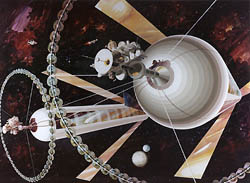O'Neill-type colony

An O'Neill-type colony is a large orbiting space colony, of the kind proposed by Princeton's Gerard K. O'Neill, consisting of an immense rotating aluminum cylinder, the inner wall of which would be inhabited. The structure would be built of material mined from the Moon or asteroids.
O'Neill linked his ideas with Peter Glaser's Solar Power Satellite (SPS) concept. SPS's are large solar collectors in space that would beam energy for use on Earth or in space. O'Neill suggested that they too could be manufactured of extraterrestrial material and could provide an export valuable enough to make a colony economically self-sustaining.
In 1973, George Hazelrigg, also of Princeton, suggested that the L4 and L5 Lagrangian points might be ideal locations for O'Neill's large habitats. (The idea of locating a large structure at one of these special orbital points can be traced back further to the 1961 novel A Fall of Moondust by Arthur C. Clarke). L4 and L5 are points of gravitational equilibrium located on the Moon's orbit at equal distances from both Earth and the Moon. An object placed in orbit around L5 (or L4) will remain there indefinitely without having to expend fuel. The orbit around L5 has an average radius of about 140,000 km, which leaves room for a large number of space settlements even at this one location.
O'Neill envisaged the construction of a series of colonies culminating in a structure 32 kilometers long and 3.2 kilometers in radius, and capable of permanently supporting hundreds of thousands or even millions of inhabitants. Normal Earth gravity would be achieved by rotating the colony at a rate of one revolution per 114 seconds. The interior of the cylinder would have three inhabited "valleys" each containing lakes, forests, towns, and so forth. Three large mirrors, capable of being opened and closed on a regular day/night basis, would shine sunlight into the valleys, and a large parabolic collector at one end of the cylinder would focus solar energy onto steam-driven generators to provide the colony's electricity needs.


